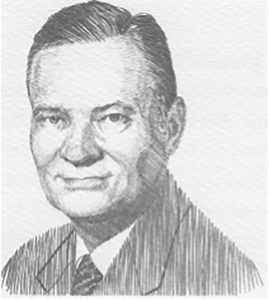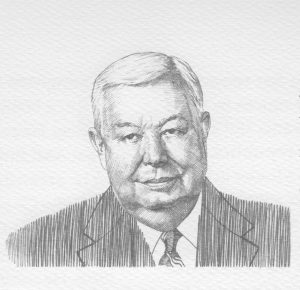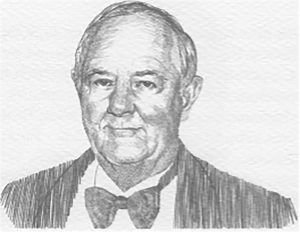Henry C. Goodrich has had four careers.
The first was as an engineer, beginning with the U.S. Navy in the Civil Engineering Corps. He then joined Rust Engineering Company, where he worked in design, construction, and management. Then he became chairman and CEO of Inland Container Corporation in Indiana, and then it was back to Birmingham to head up Southern Natural Gas. He was one of the founders of BE&K, which is now one of the largest engineering firms in the country. And along the way, he created Richgood, a venture capital and investment company, and the Goodrich Foundation, his charitable giving foundation oriented primarily toward needs in the Birmingham area. And through it all, Henry C. Goodrich has had a good time.
Henry Calvin Goodrich was born in Fayetteville, Tennessee, in 1920, the son of Dr. Charles Goodrich and Maude Baxter Goodrich. He attended grade school and high school in Fayetteville and studied pre-med at Erskine College. But he decided engineering was more his line and in 1939, he enrolled at the University of Tennessee at Knoxville.
Two years later Japan attacked Pearl Harbor and the ensuing war was going badly for the United States and its allies. Students were under pressure to finish their studies and join the war effort, and that’s exactly what Goodrich did. A year after Pearl Harbor he finished at UT, where he was chosen for both business and engineering honor fraternities and selected as president of the student chapter of the American Society of Civil Engineers. He finished his studies in 1942 and received his Bachelor of Science degree in civil engineering in 1943.
After graduation, Goodrich enlisted in the Navy (he was already in the Naval Reserve) and was sent to Camp Perry, Virginia, a training area for Seabees. As a student at UT, he had met his future wife, Billie Grace, and the couple began making plans to marry. The wedding took place in Milan, Tennessee, on September 10, 1943. There was a quick one-night honeymoon and the couple headed back to Camp Perry. There was a period of training in Norfolk, Virginia, then a transfer to Monogram Field near Suffolk, Virginia. Goodrich began making plans to head overseas and Billie Grace returned to UT to finish her degree. His overseas duty was in Panama, where he served as an assistant public works officer at the naval air station.
In 1945, with the war winding down, Goodrich began looking for post-war employment and received a job offer from Daniel Construction Company in Birmingham to work as a field engineer on a new building in Gadsden, a job that would separate him from his wife and new son for long periods. But as luck would have it, while in Birmingham, he also stopped in to visit Rust Engineering, which also offered him a job. He explained the situation to Hugh Daniel, who understood the predicament. Goodrich went to work for Rust as a draftsman/ designer. In 1950 Goodrich moved from the drafting table to the sales office and began finding clients for Rust. As Goodrich began to “network” around Birmingham, business leaders began to recognize his talents and more invitations came his way to join the Birmingham Rotary Club, to become a director at Woodward Iron Company, to be on the board at Protective Life. The man from Tennessee had taken hold in Alabama.
In his first five years in sales at Rust, he brought on 64 contracts for Rust, and in 1956 he was named a vice president of the firm. In 1961 he was made a senior vice president and a member of the Rust board of directors, responsible for the day-to-day operations of the company.
In 1967 Rust was sold to Litton Industries and Goodrich decided it was time to look for new challenges. He found them in the Hoosier State with Inland Container Corporation where he became executive vice president and director and moved his family to Indianapolis. One of his first moves at Inland was to build a new containerboard mill on the Tennessee River near ew Johnsonville, Tennessee, a state-of-the-art facility producing 300 tons per day of containerboard. The contract for the new plant went to Rust Engineering.
As he had in Birmingham, Goodrich sought out ways to serve Indianapolis as he had Birmingham, and he became active in several major civic activities. In 1969 he was elected president and chief executive officer of Inland. It was a busy time at Inland, but as always, Goodrich was never one to turn down an opportunity. So, when three old friends from Rust approached him to discuss starting an engineering firm, Goodrich listened. He agreed to help raise start-up money and in 1972, BE&K was born. In less than a year, the firm had landed a major contract and was on its way.
Inland continued to prosper and was on the Fortune 500 list. Goodrich was elected chairman of the board, and he began to spend more time at the family lake house on Lake Logan Martin near Birmingham and began to look for ways to make his exit from Inland. In 1978 Inland was acquired by Time, Inc. with Goodrich remaining in charge.
As Goodrich was relaxing at the Logan Martin Lakehouse, he received a call from John Shaw, president, and CEO of Southern Natural Resources, the huge Birmingham-based energy company on whose board Goodrich had served for seven years. At age 59, he was offered the job of president, and ultimately CEO, of Southern Natural Resources. Under Goodrich the company, renamed SONAT, set records for earnings, dividends increased and in 1981 Goodrich was named the top CEO in the gas pipelines industry.
In 1985 Goodrich retired from SONAT. Meanwhile, in Japan, the world’s largest enclosed semisubmersible offshore drilling rig was being constructed. And it was named the Henry Goodrich, for the chairman of SONAT Offshore (a SONAT subsidiary) and which was christened by Billie Grace Good rich.
Goodrich has held directorships in a host of companies, including SONAT, Inc., and subsidiaries; Time Incorporated, Ball Corporation, BE&K – Emeritus, Cousins Properties, Inc. – Emeritus, Temple-Inland Inc., Inland Steel, Indiana National Bank, Rust Engineering Company, and subsidiaries, Georgia-Kraft, Indiana Bell, BioCryst, Inc., Southern Research Technology, Protective Life Corporation, Woodward Iron Company, and Stokely-Van Camp.
His civic activities have included the Birmingham Chamber of Commerce, the United Way of Birmingham, Community Chest of Indianapolis, Birmingham Council, Boy Scouts of America, Indian Springs School trustee, Salvation Army director, the University of Alabama at Birmingham President’s Council, director of Alabama Supercomputer Project, vice president and national trustee for the Birmingham Museum of Art and the Community Foundation of Greater Birmingham.
He is a member of the American Society of Civil Engineers and is registered as a professional engineer in 12 states. He is a member of the Newcomen Society and an emeritus member of the University of Tennessee Development Council, as well as a senior director for the UAB Research Foundation.
He received the Nathan W. Doughtery Award from the University of Tennessee College of Engineering and was Industry Man of the Year in Indianapolis in 1974. The following year he was named Papermaker of the Year by Pulp and Paper Magazine and received an honorary Doctor of Laws degree from Butler University. In 1978 he was awarded an honorary Doctor of Business Administration degree from Marion College. Three years later, in 1981, he was chosen Best Chief Executive in Gas Industry. Two other honorary Doctor of Law degrees followed, from Birmingham-Southern College in 1985, and from UAB in 1986, the same year he was inducted into the Alabama Academy of Honor and selected as one of 12 Outstanding Scientists and Engineers from Tennessee. He received the Silver Beaver Award from the Boy Scouts of America in 1987 and was inducted into the Alabama Engineering Hall of Fame in 1991.






